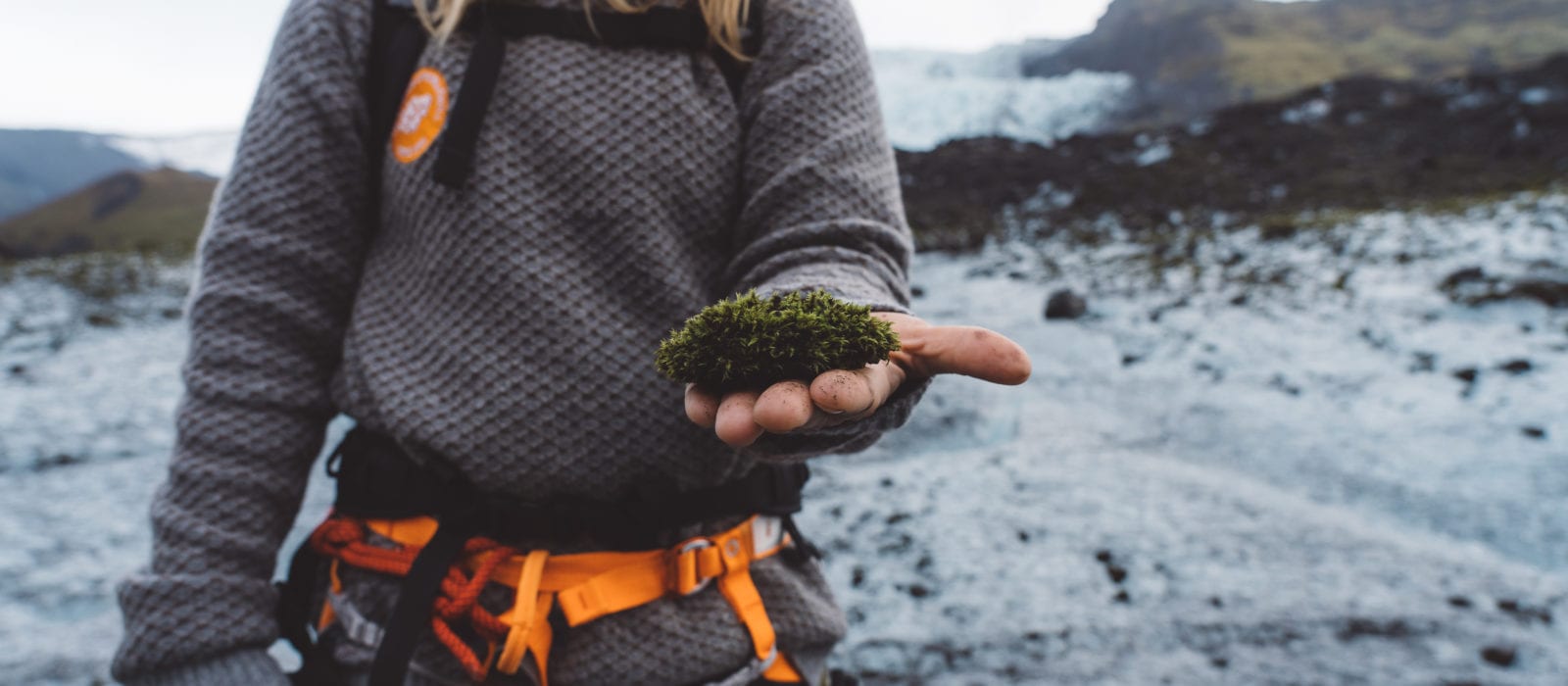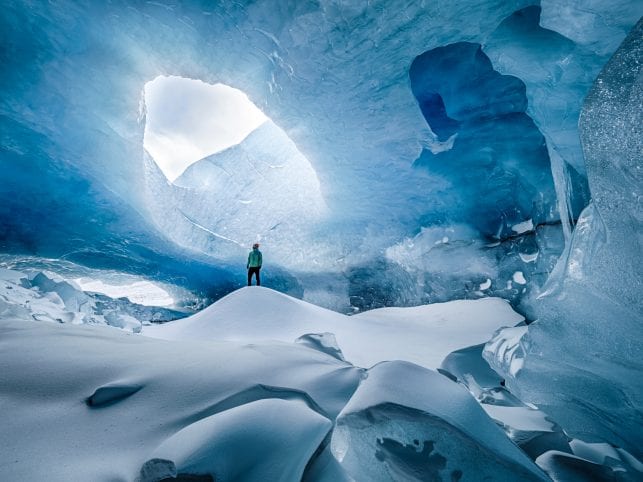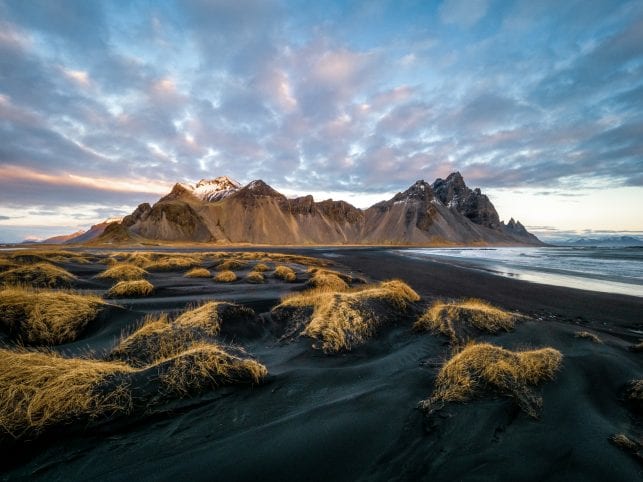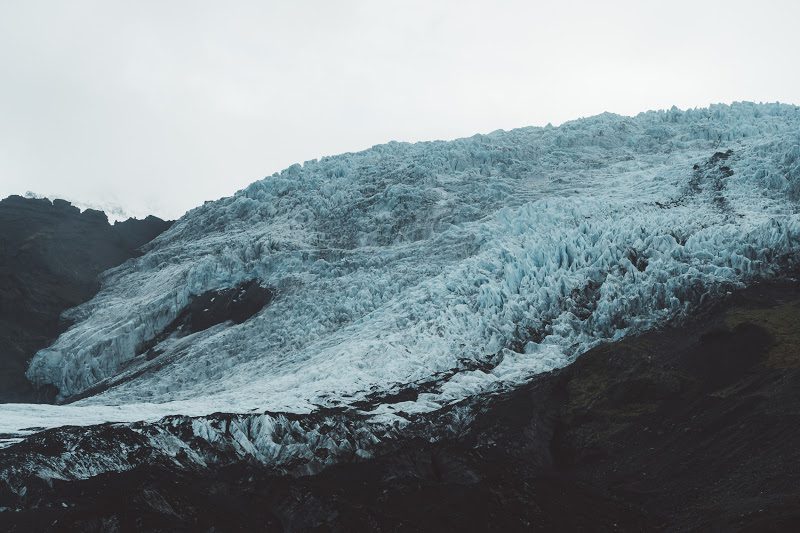
Of all the beautiful glaciers in the Skaftafell region of Vatnajökull, Falljökull glacier is the one many locals in the area are privileged to call their workplace. Falljökull glacier is famous for its steep, flowing ice fall and dramatic mountains. You’ll find many photos of the icefall and the undulating waves of ice in travellers’ holiday albums, because who could come to Iceland without checking out its namesake?
Falljökull glacier or the ‘falling glacier’ stems from the main ice cap Vatnajökull glacier, which itself is around 8% of Iceland´s total landmass. Falljökull glacier is what we call a ‘glacier tongue’ in that it’s a smaller glacier that comes off the larger ice cap, like a stream coming from a lake. The glacier was first formed high up above the mountains in the ice cap, where the yearly snowfall compressed down over time to become the special glacier ice, which melts much more slowly than regular ice that develops at freezing point. The ice that we hike on in the Vatnajökull national park ranges anywhere from 400 to 1,000 years old since it was last snow!
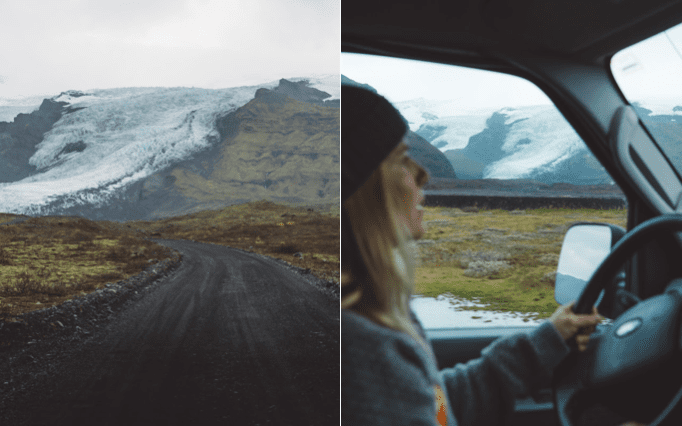
A glacier hiking or ice climbing tour onto Falljökull glacier begins from Freysnes gas station, located just a 5 minute drive from the glacier carpark. You catch your first glimpse of the glacier after heading past the Svínafell settlement, and can watch the tallest peak of Iceland, Hvannadalshnjúkur rising up at 2,110m tall, right until we dip deeper into the Falljökull valley.
We drive as far as we can into the valley along an old sheep track that was put in by the local farmers, before the area was made into a national park. The track is still in use today to round up all the sheep that call the valley home during the summer, during the annual sheep round-up called ‘réttir’. Our super jeep makes light work of the rough terrain, and within just 15 short minutes we’ve made it from the meeting point to the terminal face of the glacier.

Before putting on our crampons and stepping onto the hard glacier ice, we need to ascend one of the many hills of ‘dead ice’ at the end of the glacier. These hills are made of hard glacier ice, and due to being covered by a thick layer of ash and rocky debris, they are protected from melting away in the sun. We reach the edge of the ice, have a quick lesson in walking in crampons, a small safety briefing, and then we’re off.
Taking your first, crunching steps on a glacier is a vivid sensory memory to store away for decades to come. The crunch, crunch, crunch of crampons biting into crusty white ice, the trickle of the refreshingly cold glacier melt water flowing over the surface and the feeling of the cool wind coming off the ice cap.
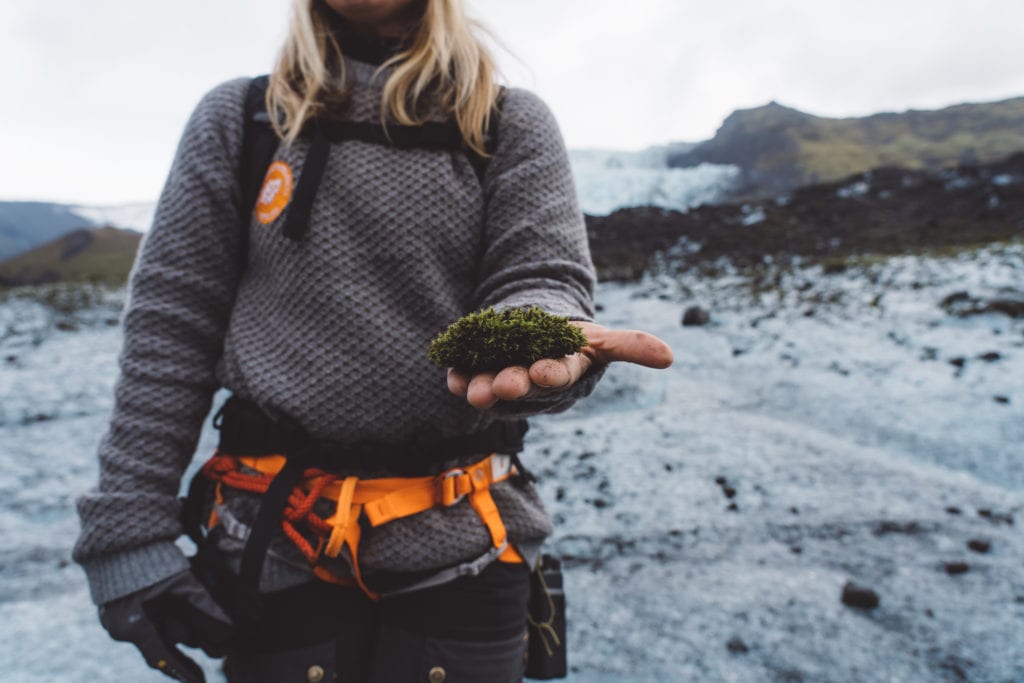
Within just a minute of hiking we approach one of Iceland’s most delicate natural phenomenon – the glacier mouse. Inside each little fuzzy bright green ball of moss is a stone that has waited patiently, over 20 years each side, for the moss to grow. Because the front of the Falljökull glacier is flat, dead ice, there´s no chance the glacier will dramatically open up and swallow them whole in a deep crevasse. They get their name, jökla-mýs or ‘glacier mice’ because they move very slowly with the smaller levels of movement and melt, rolling over occasionally to keep the balance of moss growing on all sides. We could talk for hours about how cool glacier mice and the little organisms living inside are, like tardigrades, but we’ve got hiking to get to!
There are a few routes you can take up the glacier, depending on how technical or relaxed you’d like to be. You can choose from a few levels of hikes – introductory, intermediate, and advanced with ice climbing.

Our Tours
The Glacier Encounter is a gentle hike on the lower, flatter section with a view of the icefall from below. This hike weaves in and out of the relaxed waves where the crevasses flatten out again and explores lots of interesting features, vertical walls, deep moulins and lots of streams to drink from! You can expect a physically easy, but action-packed hour on the ice itself.
In this lower section of the glacier we also come across something very characteristic of Icelandic glaciers – the volcanic ash. We see it collected in small, volcano-like cones and in great streaks across the surface. Falljökull glacier sits beneath Öræfajökull glacier, the ‘wasteland’ volcano that is one of just a few local volcanoes under Vatnajökull glacier and in Iceland. With the ash blowing on Iceland’s high winds, it spreads across the islands and glaciers quit easily.
The Glacier Discovery takes you on a longer expedition to make full use of your three hours on the ice, navigating up through the cracks and waves to the base of the icefall. Up here, the ice is moving faster and the ash is dropping into the crevasses and getting washed down the glacier by the streams. We emerge up on a second plateau and choose our path around the edges of crevasses and moulins, where we can look down into the deep blue interior of the ice. Heading up into the seracs gives us an overview all the way to the road some 4 km away. It’s hard to do the same tour twice up here because there are endless changing features to explore, but that’s the beauty of such a unique experience in nature.
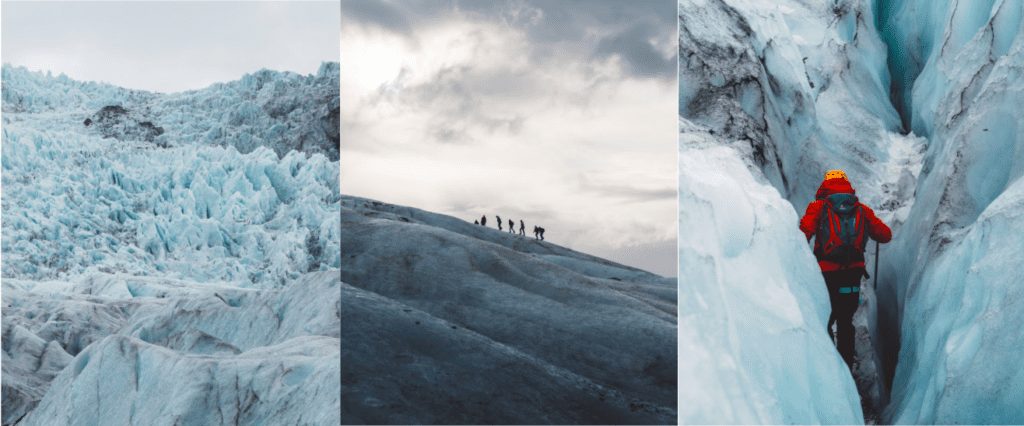
If you’re looking for a slightly tougher experience, the half-day Techniques Tour has it all, beginning in the lower section and travelling all the way up through the towering crevasses walls and deep cracks, walking along knife edges, rappelling down and ice climbing up any obstacles in our path, building it and clearing it as we go with our tools. We top out in the Discovery area of the glacier and enjoy a walk around the seracs before heading back down for a big meal at Freysnes (we’re careful not to mention the burgers until we’re on the way down, of course).
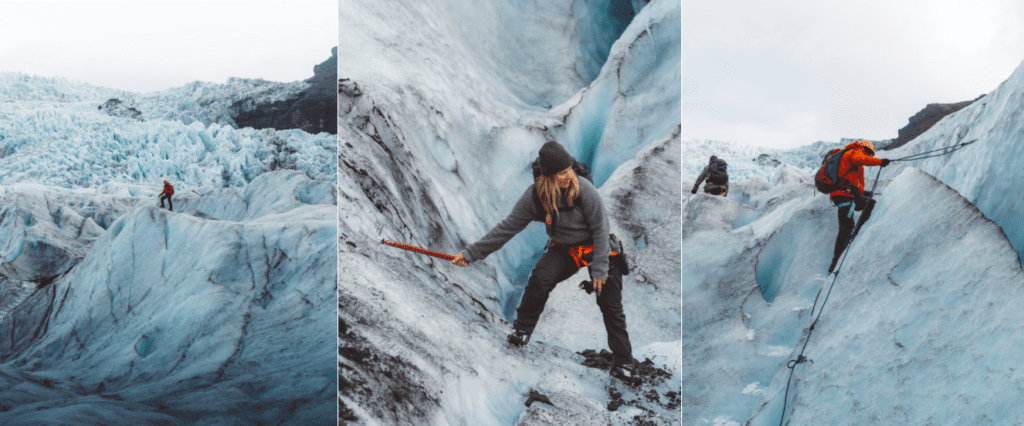
From above, we can see all the impressions the glacier has left on the valley as it has ground its way down over the centuries. This includes the moraine that was created by the glacier in the 1980’s that was eventually used as the boundary that defines the national park from the private farmer’s land.
One of the most rewarding things about climbing the glaciers is knowing that the ice beneath your feet will likely have shifted, melted, and flowed down the mountain (even if just a little!) by the time someone heads up the next day. Although the glaciers experience very gradual change, as guides and locals we’re privileged to see those changes over a longer period of time. Through our guidance and storytelling we hope we can bring to life the past, and what we hope will be a long future for our icelandic glaciers.
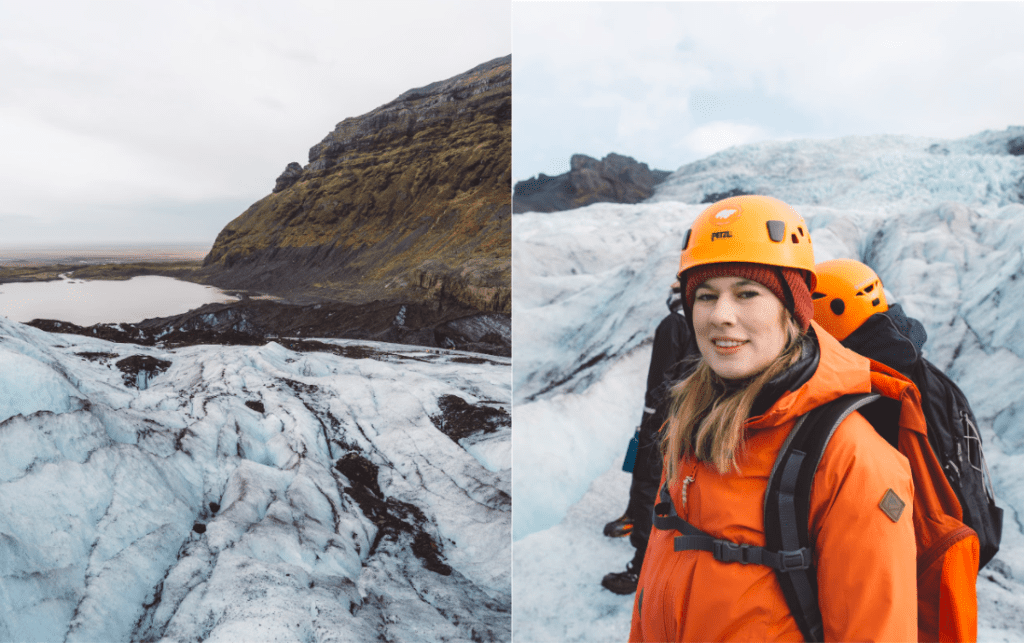
Make sure to experience the wonders of Falljökull glacier on a tour with Local Guide of Vatnajökull here
IG @localguide
